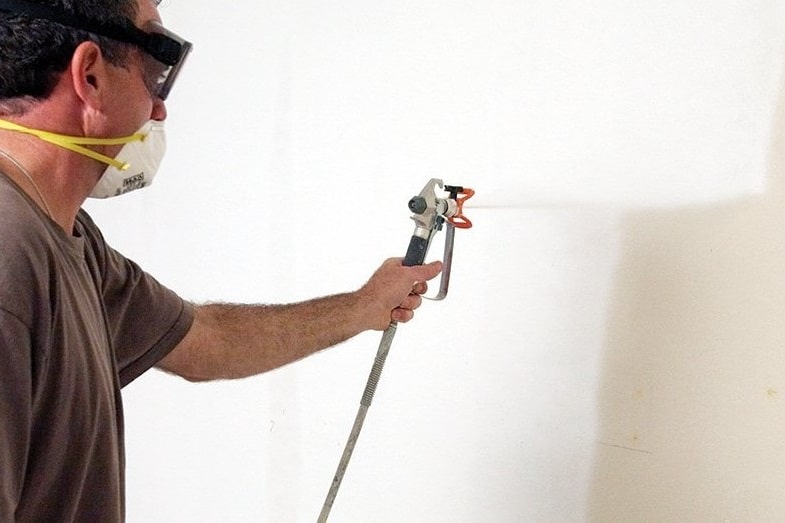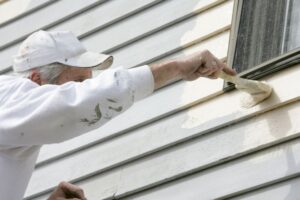How long it takes spray paint to dry varies greatly, depending on different factors. In this article, I’ll describe how long it takes, including the main factors that determine how long it takes.
How long does spray paint take to dry? After spray painting, it takes approximately 5 minutes for the surface to dry and about 60 minutes to fully harden. Among the types of spray paints in the market, epoxy or polyurethane paint dries the fastest. However, in this formulation, pausing is a must for the two ingredients to react chemically.
6 factors that determine how long it takes for spray paint to dry are as follows:
- Temperature and Humidity
- Ventilation
- Type of Surface
- Type of Spray Paint
- How You Apply the Spray Paint
- Proper Surface Prep
Read on to learn more about how long it takes spray paint to dry, including tips on how to make it dry faster.
How Long Does Spray Paint Take to Dry?
1. Temperature and Humidity
The best temperature for spray painting should be at least 50ºF to 90ºF (10ºC to 32.2ºC), with the humidity level less than 85 percent. If you want the spray paint to feel dry in about half an hour to an hour, wait for the temperature outside to be at least 65ºF to 70ºF (18.3ºC to 21.1ºC).
Extreme cold weather will prevent spray paints, especially if oil-based, from completely drying because of the heavy film. Avoid using oil-based spray paints if the temperature outside falls below 40ºF (4.4ºC).

The opposite happens when you paint in excessively hot weather conditions. The paint could dry too fast. However, in some cases, it could blister, form bumps, crack, change color, or peel.
The humidity level is another factor that influences the drying time of spray paints. If the humidity level is above 85 percent, it could cause a sticky finish or prevent the top layer paint from adhering to the substrate.
2. Ventilation
This may sound like common sense, but it’s worth mentioning. Good ventilation greatly speeds up the time it takes for spray paint to dry. It also helps removes toxic fumes.
Before you start painting any indoor space, open as many windows in the room to allow good air circulation. If possible, run several fans (window fans, exhaust fans, stand fans, etc.) to increase ventilation and push more toxic fumes out of the windows.
Keep the windows open wide for at least 48 to 72 hours after you finish spray painting the room. This way, the paint dries in record time, and you’re not compromising your health by inhaling irritating and harmful fumes.
3. Type of Surface
The next main factor that determines how long it takes for spray paint to dry is the type of surface you are painting on. Most paints are made for specific materials, and if you use them on the wrong one, they might not dry properly.
Let’s take a look at how long it takes for spray paints to dry based on the following surfaces or materials:
Metal
The average drying time of metal objects after spray painting is around 36 to 48 hours. However, the paint could dry faster if the weather is relatively warm and low in humidity—approximately 10 minutes or less.
Wood
There are opposing ideas regarding this material. Some say it takes longer for spray paint to dry on wood because it’s fully absorbed (instead of staying on top). Others say it takes only 10 to 15 minutes to dry if you’re only going to reapply the spray paint.
Cardboard
You can actually spray paint cardboard boxes. However, since cardboard boxes are absorbent, you need to prep the surface first with a primer or layers of paint to prevent them from disintegrating. Under ideal circumstances, especially if the room is well-ventilated, spray-painted cardboard could dry around 15 minutes.
Glass
It’s important to give glass enough time to dry after spray painting to prevent the formation of drip marks. Wait for 15 to 20 minutes before spraying a new layer. On average, it takes around 24 hours for the paint to dry completely.
Plastic
It may take around three hours for plastic objects to dry completely after spray painting. If you’re trying to apply additional layers of paint, you should wait at least half an hour.
Rubber
Because of its porous surface—meaning it has holes—rubber takes a minimum of 24 hours to completely dry after you’ve spray painted it. If you’re going to apply a new coat, it’s best to wait for at least half an hour.
Ideally, materials with a smooth surface will take less time to dry. On the contrary, you’ll have to wait longer for materials with a rough surface to dry after being spray painted. So how long does spray paint take to dry? The drying time depends largely on the type of surface or material you are spray painting on.
4. Type of Spray Paint
Make sure the paint you’re going to use is intended for the material you’re going to paint on. Priming the surface is also important for the paint to stick better and achieve even application.
Now, let’s have a look at each type of paint below with their drying times for spray painting.
Enamel
People use enamel paint, also called latex paint, to give any surface a polished or glossy finish. The great thing about enamel is that it doesn’t drip because it usually dries fast when exposed to air. On average, it takes around 8 hours to dry completely.
Lacquer
Lacquer paint is widely used in painting or restoring a vehicle or wood furniture to give it a clear (or colored), long-lasting finish. You can use it as is or combine it with other paints to create a better finish.
The drying time of lacquer paints could vary for every brand. For instance, the Rust-Oleum® Specialty Lacquer dries to touch within 20 to 30 minutes. Other lacquer paints might be dry to touch in 3 to 5 minutes and are fully dry in 3 hours.
Epoxy or Polyurethane
Epoxy or polyurethane spray paint must chemically react with one another to dry. In most formulations, this could happen in 2 to 4 hours. However, it takes 24 hours to dry completely.
Acrylic
Acrylic spray paint is used for various projects and materials, including ceramic, glass, hardboard, metal, and plastic. Surface drying of acrylic paint takes as fast as 10 to 30 minutes. The hard drying time is 8 hours, but it’s best to wait 24 hours before spraying another acrylic paint coat.
Vinyl
Like most spray paints, the drying time of vinyl paint depends on the ambient temperature of the painting’s environment. It needs an environment of 70°F (21°C) and relative humidity of at least 50 percent.
In general, the dry-touch time of vinyl paint is around one hour. However, you’ll need to wait at least 6 to 48 hours before using the painted object.
Alkyd
Alkyd paint is an oil-based spray paint that produces a high shine, durable finish that’s resistant to dirt and stains. Depending on the environmental conditions and product you’re using, the touch-dry time of most alkyd paints is between 6 and 8 hours. You can safely recoat after 16 hours.
Latex
Latex is the umbrella term for water-based paints, specifically acrylic, latex, and vinyl styrene paints. If you paint in a room temperature environment, latex paints usually become completely dry to touch within one hour or less. However, you need to wait around four hours before spraying additional layers.
5. How You Apply the Spray Paint
The goal is to start with a thin layer of paint before slowly increasing the thickness of the succeeding layers. If you spray thin coats, the surface of the paint layer dries reasonably fast. It’ll also give the surface a smoother and more uniform look.
The type of spray painting tool you’re going to use will definitely affect your paint job’s outcome. There are currently two general types of spray painting tools used by professionals and non-professionals: aerosol spray can and paint sprayer guns.
Depending on the type you use, paint sprayer guns (airless) are generally efficient and accurate. They also prevent paint waste and overspray.

Aerosol spray paints have caps and nozzles that come in different shapes and sizes to create thin or thick lines. Unlike paint sprayer guns, you don’t need to worry about maintenance or mixing if you use aerosol spray paints.
The best tool for spray painting depends on the material and your purpose. If you want more control over the paint’s viscosity and add drying agents to the mixture anytime, paint sprayer guns are preferable.
Another consideration is the distance of the spray paint tool from the surface or object you intend to paint. Aim for a distance of 6 to 8 inches. Be sure to do a thin, even coat while making a sweeping motion to avoid dripping and waiting long between coats. So how long does it take for spray paint to dry? The drying time depends largely on how you apply the spray paint.
6. Proper Surface Prep
Prepping any material for spray painting is a must. According to a book by Wolfgang Maasberg, up to 80 percent of coating failures are caused by improper surface prep and cleaning. [1]
Depending on the material you’re going to paint on, a complete surface prep work usually includes the following steps:
- Cleaning (using ordinary household detergent, bleach and water solution, or mineral spirits)
- Repairing (involves filling holes and cracks with caulk or filler)
- Sanding
- Patching
- Masking (using a painter’s tape)
- Priming to seal the surface
Below are some of the things you need to remember when preparing the surface of objects made of metal, wood, glass, plastic, rubber, or cardboard.
Metal
You can use mineral spirits, also known as mineral turpentine, to get rid of grease and dirt on metal surfaces. To remove old paint or de-gloss the surface, you need to do light sanding using fine sandpaper and then remove dust with a clean, dry cloth. Next, apply a coat of rust-inhibiting, spray-on primer.
Depending on the brand, it usually takes around 24 hours before you can spray another primer layer. The Rust-Oleum metal primer takes 2 to 4 hours before it’s dry to the touch.
Wood
You don’t always need to sand wooden surfaces unless they have an existing finish (old paint, lacquer, polyurethane, shellac, or varnish) or obvious damage. Besides sandpaper, you could use certain chemicals to do this job faster and more efficiently.
Whatever you do, avoid using water to clean the surface of any wooden object because it can damage it. Use a dry tack cloth or vacuum cleaner to remove dust or dirt.
Priming is also important to do before spray painting unfinished wood because it tends to really soak up paint. Apply a minimum of two primer coats to help fill in the wood grain and imperfections.
Most water-based wood primers, like latex primers, take only 30 minutes to one hour to dry out. Meanwhile, oil-based wood primers take a minimum of eight hours to dry completely.
Glass
When it comes to spray painting glass, start by thoroughly washing it using warm, soapy water to get rid of grease, dirt, and dust.
Make sure the glass is completely free from soap film before spraying it with paint. Some brands, like Krylon, suggest wiping down the glass with rubbing alcohol (then letting it dry completely).
Plastic
You still need to lightly sand plastic with sandpaper (220- to 300-grit) for it to accept paint. However, unlike the other materials previously mentioned, it’s not always necessary to apply a primer on plastic objects. If the surface is clean and sanded, you’re good to go.
Rubber
Clean the rubber with water and dish soap, wash it again, and let it dry completely before proceeding to the next step, which is priming. Coat the surface with a flexible primer to let the paint (usually acrylic paint) dry completely and stick to the rubber better.
Cardboard
After cleaning and applying a primer, you may have to wait around 24 hours before you can start spray painting on the cardboard. If the cardboard’s surface is too coarse after priming, you can gently sand it down using very fine sandpaper (240-grit, 320-grit, or 400-grit) or extra-fine sandpaper (grits up to 600).
Conclusion – How Long Does Spray Paint Take to Dry?
So, to recap, how long does spray paint take to dry? After spray painting, it takes about 5 minutes for the surface to dry and about 60 minutes to fully harden. Epoxy spray paint dries the fastest; however, you must occasionally pause to allow the ingredients to react chemically and dry.
Many factors influence the drying time of spray paints. You need to consider the formulation used by each brand, the quality of the brand, and the use of reducers and hardeners.
6 of the main factors that determine how long it takes for spray paint to dry are as follows:
- Temperature and Humidity
- Ventilation
- Type of Surface
- Type of Spray Paint
- How You Apply the Spray Paint
- Proper Surface Prep


![How Long Does DayQuil Last? [How Long It Stays in Your System] how long does dayquil last](https://howchimp.com/wp-content/uploads/2021/06/how-long-does-dayquil-last-300x200.jpg)
![How Long Does DHL Take to Deliver? [DHL Delivery Time] How Long Does DHL Take to Deliver](https://howchimp.com/wp-content/uploads/2021/05/how-long-does-DHL-take-to-deliver-300x200.jpg)
![Read more about the article Baby Brown Recluse Spider: How to Identify, Is It Dangerous? [With Pictures]](https://howchimp.com/wp-content/uploads/2021/05/baby-brown-recluse-300x200.jpg)
